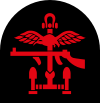British Commando
| British Commandos | |
|---|---|

|
|
| Active | 1940–1946 |
| Allegiance |
|
| Branch |
|
| Type | Commando |
| Role | Coastal raiding Assault infantry Special operations |
| Part of | Combined Operations |
| Engagements | Second World War |
| Commanders | |
| Notable commanders |
Robert Laycock John Durnford-Slater Lord Lovat Ronnie Tod |
| Insignia | |
| Combined Operations Tactical recognition flash |
 |
The British Commandos were formed during the Second World War in June 1940, following a request from the Prime Minister of the United Kingdom, Winston Churchill, for a force that could carry out raids against German-occupied Europe. Initially drawn from within the British Army from soldiers who volunteered for the Special Service Brigade, the Commandos' ranks would eventually be filled by members of all branches of the British Armed Forces and a number of foreign volunteers from German-occupied countries.
Reaching a wartime strength of over 30 units and four assault brigades, the Commandos served in all theatres of war from the Arctic Circle to Europe and from the Mediterranean and Middle East to South-East Asia. Their operations ranged from small groups of men landing from the sea or by parachute, to a brigade of assault troops spearheading the Allied invasions of Europe and Asia.
After the war most Commando units were disbanded, leaving only the Royal Marines 3 Commando Brigade. The modern Royal Marine Commandos, Parachute Regiment, Special Air Service and Special Boat Service trace their origins to the Commandos. The Second World War Commando legacy also extends to mainland Europe and the United States, the French Naval commandos, Dutch Korps Commandotroepen, Belgian Paracommando Brigade and the United States Army Rangers were influenced by the wartime Commandos.
...
Wikipedia
